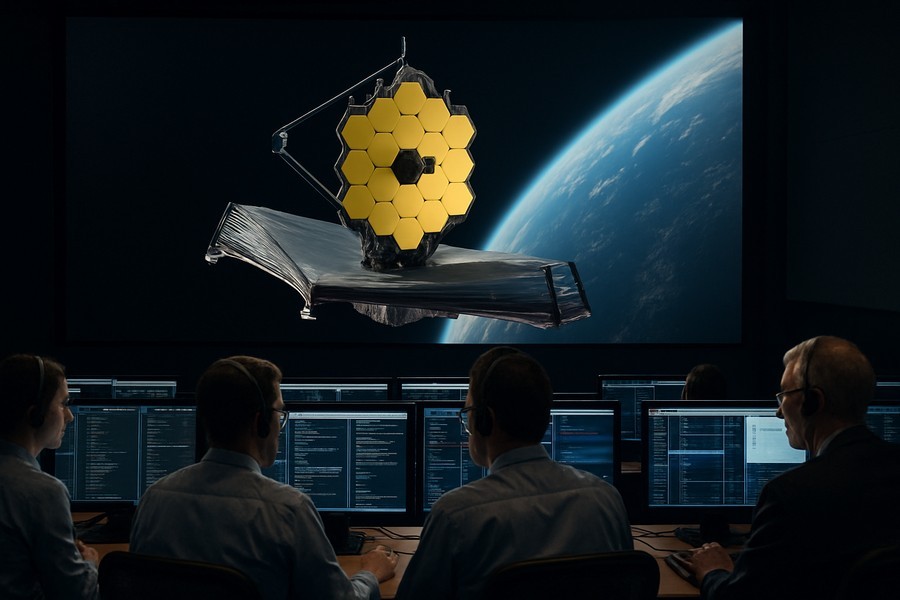
Revolutionizing Telescope Technology: A Glimpse into the Future
Upon its successful launch, we experienced a sigh of relief as the state-of-the-art space telescope embarked on its journey. This was a huge leap in telescope technology, the likes of which hadn't been seen since the launch of the first major telescope back in 1990. The impressive feat was not without its challenges; the spacecraft had to flawlessly steer through 344 potential points of failure. But all the anxiety was worth it in the end.
Half a year later, we were amazed by the first images it captured. The telescope had been able to photograph the most far-off galaxies ever seen. But for our team, this was just the beginning.
High-Resolution Observations with Advanced Instruments
We were working with the most precise mode of the telescope, known as the aperture masking interferometer or AMI. This small but intricate piece of metal was designed to fit into one of the telescope's cameras, boosting its resolution. The results of our meticulous experiments and enhancements of the AMI have now been shared across a series of scientific papers. It's a proud moment for us to finally unveil its successful observations of stars, planets, moons, and even black hole jets.
Unlike the first major telescope, which was conveniently located a few hundred kilometers above the Earth's surface, our new space telescope is located approximately 1.5 million kilometers away. This means we can't physically reach it to perform maintenance or repairs. Therefore, we needed a solution that would allow us to rectify any issues without the need to change any hardware.
AMI: A Game-Changer in Space Telescopes
The AMI was the answer. This piece of hardware was the only one of its kind from our team, designed by a brilliant astronomer. Its primary function was to diagnose and measure any blur in the images captured by the telescope. The accuracy of the telescope's 18 hexagonal primary mirrors and its multiple internal surfaces is crucial to the study of planets and black holes. Even a slight distortion of a few nanometers can blur the images and critically affect the sensitivity and resolution.
Dealing with Blurry Pixels
Our team had high hopes for the AMI. We planned to use it to observe the birthplaces of planets and materials being sucked into black holes. However, we soon noticed that the images were somewhat blurry due to an electronic effect. Brighter pixels were leaking into their darker neighbors, causing the images to appear slightly fuzzy. This wasn't a mistake or flaw, but a characteristic of infrared cameras that turned out to have a significant impact on the telescope's performance.
This was a major obstacle for observing distant planets that are thousands of times fainter than their stars and located just a few pixels away. It was quickly apparent that this issue was more than ten times worse than we anticipated. So, we started working on a solution.
Refining the Telescope's Vision
Our team conducted a series of experiments and built a computer model to simulate the optical physics of the AMI. We connected this to a machine learning model to represent the electronics. After some test runs and validation, we were able to calculate and undo the blur in other data, restoring the AMI to full function. The system doesn't alter what the telescope does in space but corrects the data during processing.
Our correction method proved to be successful. The telescope was able to clearly capture a faint planet and the reddest-known brown dwarf, which were previously out of reach. This significant breakthrough has paved the way for using the AMI to search for unknown planets at resolutions and sensitivities previously thought impossible.
Pushing the Limits of Telescope Technology
Not only does this system work on individual dots, but it can also form complex images at the highest resolution. By applying the new correction, we were able to clearly track the rotation of Jupiter's moon Io and its volcanoes over an hour-long timelapse. Additionally, the telescope was able to accurately capture images of a jet launched from the black hole at the center of a distant galaxy, matching images from much larger telescopes.
The tools developed for the AMI could potentially be used for more complex cameras on future space telescopes. These instruments require an optical calibration so precise that it's just a fraction of a nanometer, beyond the capacity of any known materials. But our team's work shows that if we can accurately measure, control, and correct the materials we have, we can continue to explore the distant corners of our galaxy and potentially discover Earth-like planets.
